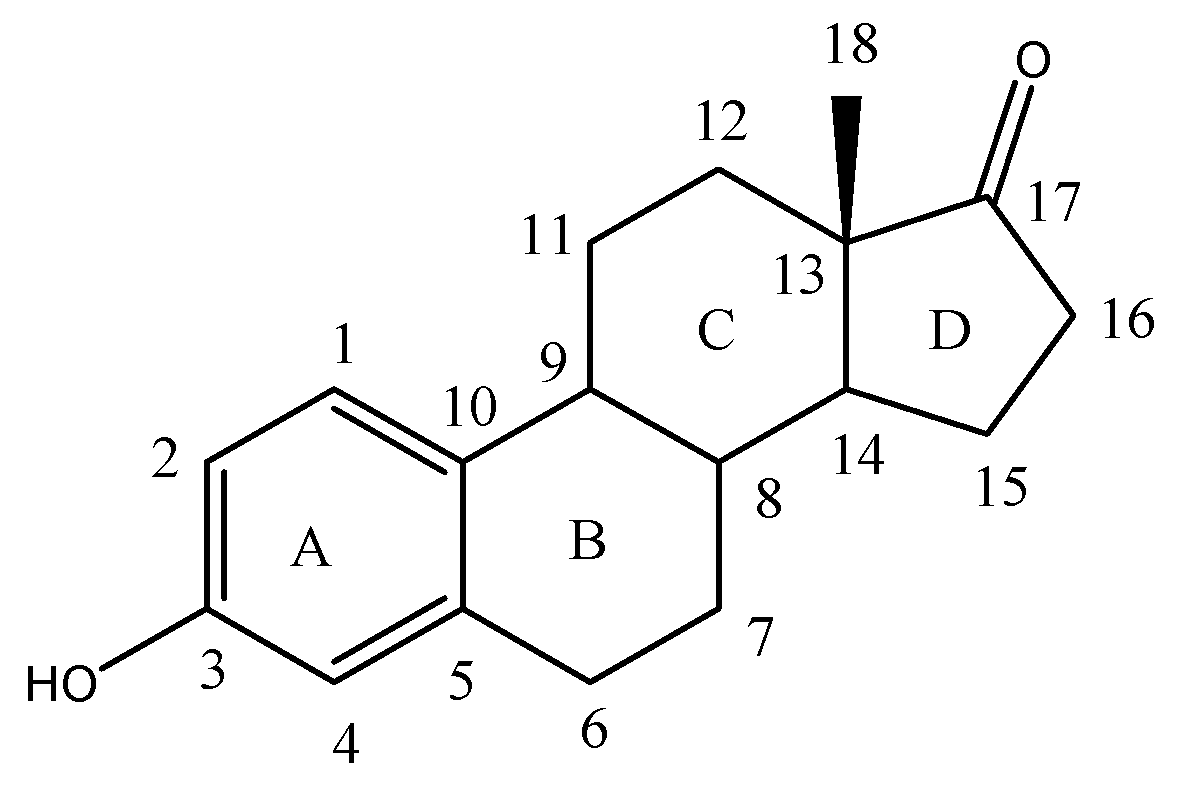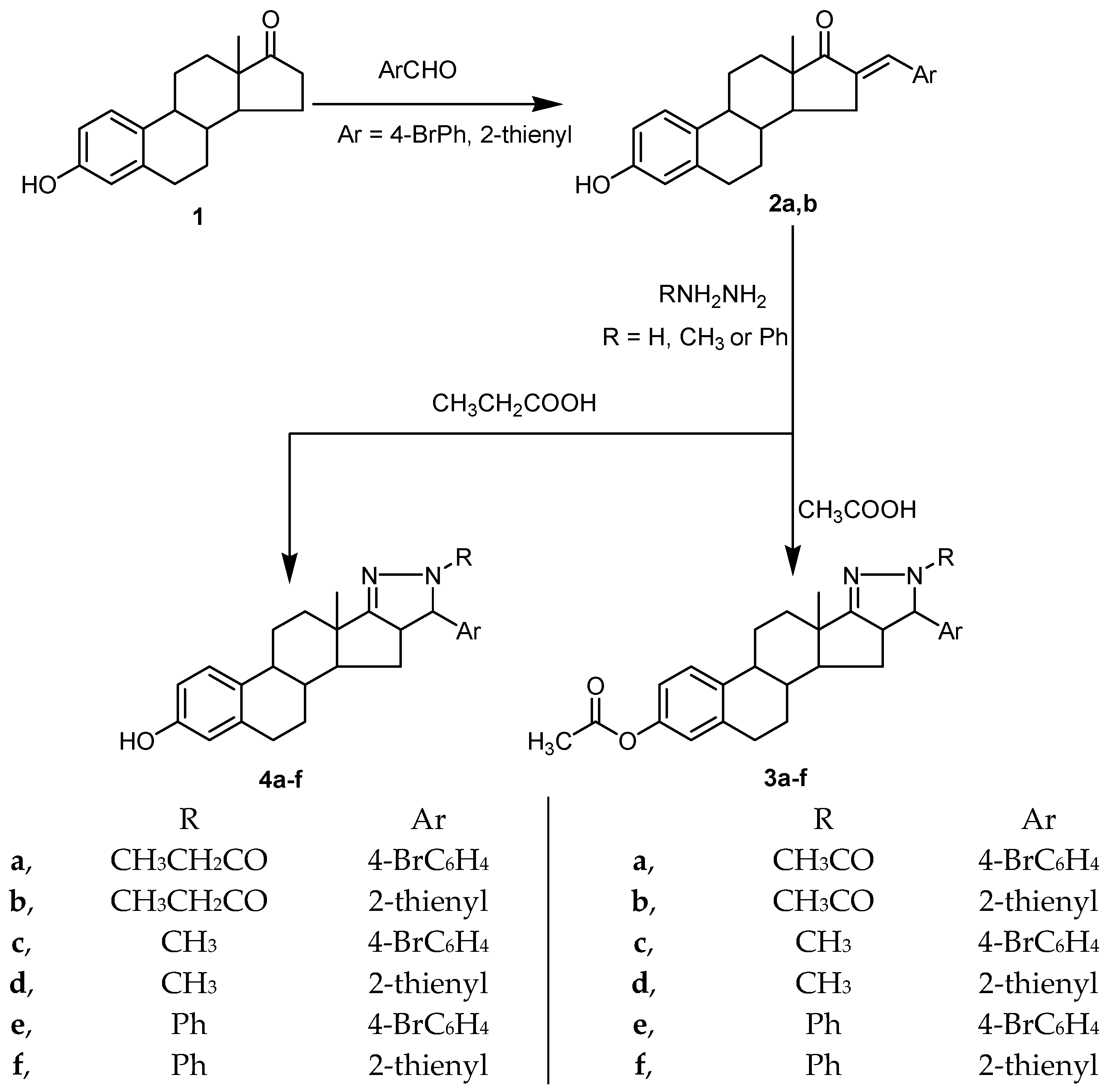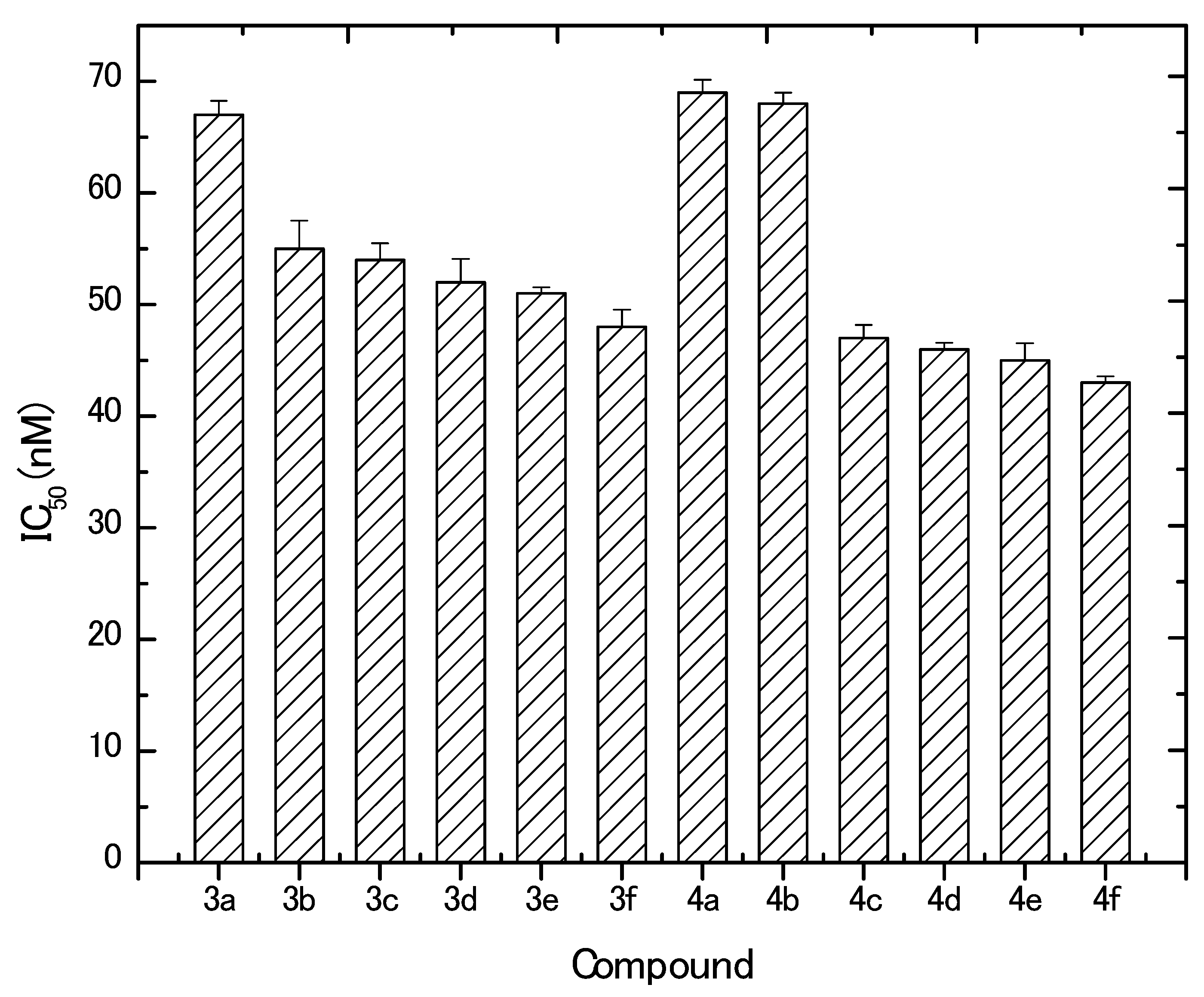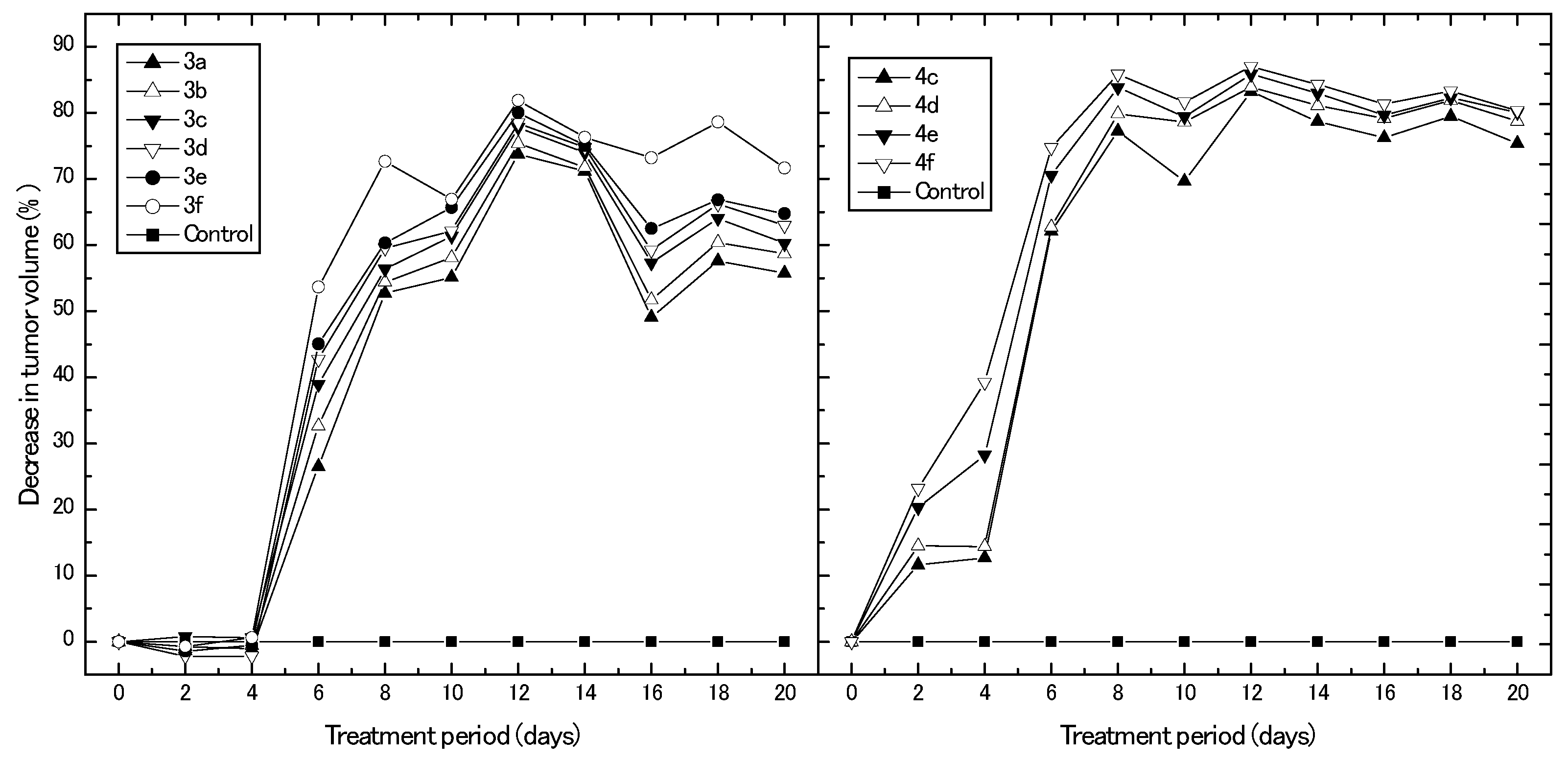In Vitro and In Vivo Anti-Breast Cancer Activities of Some Synthesized Pyrazolinyl-estran-17-one Candidates
Abstract
1. Introduction
2. Results and Discussion
2.1. Chemistry
2.2. Biological
2.2.1. Cytotoxic Activity
2.2.2. In Vivo Xenograft Model Results
3. Materials and Methods
3.1. Chemistry
3.1.1. Synthesis of 3-hydroxy-16-[(aryl) methylene]-estra-1(10),2,4-trien-17-one (2a,b)
3.1.2. Synthesis of 1′-substituted-1′H-5′-aryl-estra-1(10),2,4-trien-[17,16-c]pyrazoline-3-acetate derivatives (3a–f)
3.1.3. Synthesis of 1′-propionyl-1H-5′-(aryl)-estra-1(10),2,4-trien[17,16-c]pyrazoline-3-ol derivatives (4a–b) and 1′-substituted-1′H-5′-aryl-estra-1(10),2,4-trien-[17,16-c]pyrazoline-3-ol derivatives (4c–f)
3.2. Biological Assays
3.2.1. In Vitro Cytotoxicity Assay
3.2.2. Human Breast Cancer Xenograft Models and Animal Treatment
4. Conclusions
Author Contributions
Funding
Conflicts of Interest
References
- Kuhl, H. Pharmacology of estrogens and progestogens: Influence of different routes of administration. Climacteric 2005, 8, 3–63. [Google Scholar] [CrossRef] [PubMed]
- Hershberg, E.B.; Rubin, M.; Schwenk, E. Synthesis of estrone from androstadienedione. J. Org. Chem. 1950, 15, 292–300. [Google Scholar] [CrossRef]
- Gupta, A.; Kumar, B.S. Current status on development of steroids as anticancer agents. J. Steroid Biochem. Mol. Biol. 2013, 137, 242–270. [Google Scholar] [CrossRef] [PubMed]
- Dudenkov, T.M.; Ingle, J.N.; Buzdar, A.U.; Robson, M.E.; Kubo, M.; Ibrahim-zada, I.; Batzler, A.; Jenkins, G.D.; Pietrzak, T.L.; Carlson, E.E. SLCO1B1 polymorphisms and plasma estrone conjugates in postmenopausal women with ER plus breast cancer: Genome-wide association studies of the estrone pathway. Breast Cancer Res. Treat. 2017, 164, 189–199. [Google Scholar] [CrossRef] [PubMed]
- Banerjee, N.; Miller, N.; Allen, C.; Bendayan, R. Expression of membrane transporters and metabolic enzymes involved in estrone-3-sulphate disposition in human breast tumour tissues. Breast Cancer Res. Treat. 2014, 145, 647–661. [Google Scholar] [CrossRef] [PubMed]
- Schönecker, B.; Lange, C.; Kötteritzsch, M.; Günther, W.; Weston, J.; Anders, E.; Görls, H. Conformational design for 13α-steroids. J. Org. Chem. 2000, 65, 5487–5497. [Google Scholar] [CrossRef] [PubMed]
- Jovanovic-Santa, S.; Petrović, J.; Andrić, S.; Kovačević, R.; Ðurendić, E.; Sakač, M.; Lazar, D.; Stanković, S. Synthesis, structure, and screening of estrogenic and antiestrogenic activity of new 3,17-substituted-16,17-seco-estratriene derivatives. Bioorg. Chem. 2003, 31, 475–484. [Google Scholar] [CrossRef]
- Minorics, R.; Bózsity, N.; Wölfling, J.; Mernyák, E.; Schneider, G.; Márki, A.; Falkay, G.; Ocsovszki, I.; Zupkó, I. Antiproliferative effect of normal and 13-epi-d-homoestrone and their 3-methyl ethers on human reproductive cancer cell lines. J. Steroid Biochem. Mol. Biol. 2012, 132, 168–175. [Google Scholar] [CrossRef] [PubMed]
- Jojart, R.; Wolfling, J.; Schneider, G.; Herman, B.E.; Szecsi, M.; Mernyak, E. Synthesis of novel 13α-estrone derivatives by Sonogashira coupling as potential 17β-HSD1 inhibitors. Beilstein J. Org. Chem. 2017, 13, 1303–1309. [Google Scholar] [CrossRef]
- Ayan, D.; Roy, J.; Maltais, R.; Poirier, D. Impact of estradiol structural modifications (18-methyl and/or 17-hydroxy inversion of configuration) on the in vitro and in vivo estrogenic activity. J. Steroid Biochem. Mol. Biol. 2011, 127, 324–330. [Google Scholar] [CrossRef] [PubMed]
- Mernyák, E.; Kovács, I.; Minorics, R.; Sere, P.; Czégány, D.; Sinka, I.; Wölfling, J.; Schneider, G.; Újfaludi, Z.; Boros, I.; et al. Synthesis of trans-16-triazolyl-13α-methyl-17-estradiol diastereomers and the effects of structural modifications on their in vitro antiproliferative activities. J. Steroid Biochem. Mol. Biol. 2015, 150, 123–134. [Google Scholar] [CrossRef] [PubMed]
- Szabó, J.; Bacsa, I.; Wölfling, J.; Schneider, G.; Zupkó, I.; Varga, M.; Herman, B.E.; Kalmár, L.; Szécsi, M.; Mernyák, E. Synthesis and in vitro pharmacological evaluation of N-[(1-benzyl-1,2,3-triazol-4-yl)methyl]-carboxamides on d-secoestrone scaffolds. J. Enzym. Inhib. Med. Chem. 2016, 31, 574–579. [Google Scholar] [CrossRef] [PubMed]
- Szabó, J.; Jerkovics, N.; Schneider, G.; Wölfling, J.; Bózsity, N.; Minorics, R.; Zupkó, I.; Mernyák, E. Synthesis and in Vitro antiproliferative evaluation of C-13 epimers of triazolyl-d-secoestrone alcohols: The first potent 13α-d-secoestrone derivative. Molecules 2016, 21, 611. [Google Scholar] [CrossRef] [PubMed]
- Szabó, J.; Pataki, Z.; Wölfling, J.; Schneider, G.; Bózsity, N.; Minorics, R.; Zupkó, I.; Mernyák, E. Synthesis and biological evaluation of 13α-estrone derivatives as potential antiproliferative agents. Steroids 2016, 113, 14–28. [Google Scholar] [CrossRef] [PubMed]
- Rao, P.N.; Cessac, J.W.; Tinley, T.L.; Mooberry, S.L. Synthesis and antimitotic activity of novel 2-methoxyestradiol analogs. Steroids 2002, 67, 1079–1089. [Google Scholar] [CrossRef]
- Amr, A.E.; Abdulla, M.M. Synthesis and anti-inflammatory activities of new cyanopyrane derivatives fused with steroidal nuclei. Arch. Pharm. 2006, 2, 885–895. [Google Scholar] [CrossRef] [PubMed]
- Amr, A.E.; Abdel-Latif, N.A.; Abdalla, M.M. Synthesis of some new testosterone derivatives fused with substituted pyrazoline ring as promising 5α-reductase inhibitors. Acta Pharm. 2006, 56, 203–218. [Google Scholar]
- Abdulla, M.M.; Amr, A.E.; Al-Omar, M.A.; Hussain, A.A.; Amer, M.S. Synthesis and Reactions of Some New Substituted Androstanopyrazoline and Androstanoisoxazole Derivatives Using Their Arylmethylene as Starting Materials. Life Sci. J. 2013, 10, 599–607. Available online: http://www.lifesciencesite.com (accessed on 28 September 2013).
- Day, J.M.; Foster, P.A.; Chander, S.K.; Tutill, H.J.; Parsons, M.F.C.; Allan, G.M.; Lawrence, H.R.; Vicker, N.; Potter, B.V.L.; Reed, M.J.; et al. Inhibition of Estrone-Dependent Tumor Growth In Vivo by the 17β-HSD1 Inhibitor, 2-ethyl-16β-m-Pyridylmethylamidomethyl-estrone (2-EtE1-F). Breast Cancer Res. Treat. 2006, 100, S197. Available online: http://www.w3.org/1999/xlink" xlink:href="https://insights.ovid.com/breast-cancer-research-treatment/bcart/2006/12/001/ inhibition-estrone-dependent-tumor-growth-vivo-17/585/00001803 (accessed on 28 September 2013).
- Day, J.M.; Foster, P.A.; Tutill, H.J.; Schmidlin, F.; Sharland, C.M.; Hargrave, J.D.; Vicker, N.; Potter, B.V.L.; Reed, M.J.; Purohit, A. STX2171, a 17β-hydroxysteroid dehydrogenase type 3 inhibitor, is efficacious in vivo in a novel hormone-dependent prostate cancer model. Endocr. Relat. Cancer 2013, 20, 53–64. [Google Scholar] [CrossRef] [PubMed]
- Day, J.M.; Foster, P.A.; Tutill, H.J.; Parsons, M.F.C.; Newman, S.P.; Chander, S.K.; Allan, G.M.; Lawrence, H.R.; Vicker, N.; Potter, B.V.L. 17β-Hydroxysteroid dehydrogenase type 1, and not type 12, is a target for endocrine therapy of hormone-dependent breast cancer. Int. J. Cancer 2008, 122, 1931–1940. [Google Scholar] [CrossRef] [PubMed]
- Green, B.; Leake, R.E. Steroid Hormones: A Practical Approach; IRL Press: Oxford, UK, 1987; pp. 213–214. [Google Scholar]
- Elsayed, E.A.; Sharaf-Eldin, M.A.; Wadaan, M. In vitro evaluation of cytotoxic activities of essential oil from Moringa oleifera seeds on HeLa, HepG2, MCF-7, CACO-2 and L929 cell lines. Asian Pac. J. Cancer Prev. 2015, 16, 4671–4675. [Google Scholar] [CrossRef] [PubMed]
- Elsayed, E.A.; Farooq, M.; Dailin, D.; El-Enshasy, H.A.; Othman, N.Z.; Malek, R.; Danial, E.; Wadaan, M. In Vitro and In Vivo Biological Screening of Kefiran Polysaccharide Produced by Lactobacillus Kefiranofaciens. Biomed. Res. 2017, 28, 594–600. Available online: http://www.alliedacademies.org/articles/in-vitro-and-in-vivo-biological-screening-of-kefiran-polysaccharide-produced-by-lactobacillus-kefiranofaciens.html (accessed on 6 July 2016).
- McCauley, J.; Zivanovic, A.; Skropeta, D. Bioassays for Anticancer Activities. Methods Mol. Biol. 2013, 1055, 191–205. [Google Scholar] [CrossRef] [PubMed]
- Wang, H.; Yu, D.; Agrawal, S.; Zhang, R. Experimental therapy of human prostate cancer by inhibiting MDM2 expression with novel mixed-backbone antisense oligonucleotides: In vitro and in vivo activities and mechanisms. Prostate 2003, 54, 194–205. [Google Scholar] [CrossRef] [PubMed]
Sample Availability: Samples of the compounds are available from the authors. |




© 2018 by the authors. Licensee MDPI, Basel, Switzerland. This article is an open access article distributed under the terms and conditions of the Creative Commons Attribution (CC BY) license (http://creativecommons.org/licenses/by/4.0/).
Share and Cite
Amr, A.E.-G.E.; El-Naggar, M.; Al-Omar, M.A.; Elsayed, E.A.; Abdalla, M.M. In Vitro and In Vivo Anti-Breast Cancer Activities of Some Synthesized Pyrazolinyl-estran-17-one Candidates. Molecules 2018, 23, 1572. https://doi.org/10.3390/molecules23071572
Amr AE-GE, El-Naggar M, Al-Omar MA, Elsayed EA, Abdalla MM. In Vitro and In Vivo Anti-Breast Cancer Activities of Some Synthesized Pyrazolinyl-estran-17-one Candidates. Molecules. 2018; 23(7):1572. https://doi.org/10.3390/molecules23071572
Chicago/Turabian StyleAmr, Abd El-Galil E., Mohamed El-Naggar, Mohamed A. Al-Omar, Elsayed Ahmed Elsayed, and Mohamed M. Abdalla. 2018. "In Vitro and In Vivo Anti-Breast Cancer Activities of Some Synthesized Pyrazolinyl-estran-17-one Candidates" Molecules 23, no. 7: 1572. https://doi.org/10.3390/molecules23071572
APA StyleAmr, A. E.-G. E., El-Naggar, M., Al-Omar, M. A., Elsayed, E. A., & Abdalla, M. M. (2018). In Vitro and In Vivo Anti-Breast Cancer Activities of Some Synthesized Pyrazolinyl-estran-17-one Candidates. Molecules, 23(7), 1572. https://doi.org/10.3390/molecules23071572





